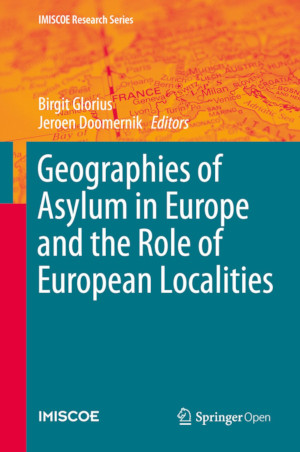Geographies of Asylum in Europe and the Role of European Localities
by Birgit Glorius, Jeroen Doomernik
DescriptionTable of ContentsDetailsHashtagsReport an issue 






Book Description
This book describes how the numerous arrivals of asylum seekers since 2015 shaped reception and integration processes in Europe. It addresses the structuration of asylum and reception systems, and spaces and places of reception on European, national, regional and local level. It also analyses perceptions and discourses on asylum and refugees, their evolvement and the consequences for policy development. Furthermore, it examines practices and policy developments in the field of refugee reception and integration. The volume shows and explains a variety of refugee reception and integration strategies and practices as specific outcome of multilevel governance processes in Europe. By addressing and contextualizing those multiple experiences of asylum seeker reception, the book is a valuable contribution to the literature on migration and integration, societal development and political culture in Europe.This open book is licensed under a Creative Commons License (CC BY). You can download Geographies of Asylum in Europe and the Role of European Localities ebook for free in PDF format (5.5 MB).
Table of Contents
Chapter 1
Introduction
Part I
Governing Asylum and Reception Within an Asylum System Under Stress
Chapter 2
Dispersal and Reception in Northern Italy: Comparing Systems Along the Brenner Route
Chapter 3
Legal Paradigm Shifts and Their Impacts on the Socio-Spatial Exclusion of Asylum Seekers in Denmark
Chapter 4
Places and Spaces of the Others. A German Reception Centre in Public Discourse and Individual Perception
Chapter 5
Before and After the Reception Crisis of 2015: Asylum and Reception Policies in Austria
Part II
Perceptions and Discourses on Refugee Reception
Chapter 6
Local Narrative-Making on Refugees: How the Interaction Between Journalists and Policy Networks Shapes the Media Frames
Chapter 7
Shaping the "Deserving Refugee": Insights from a Local Reception Programme in Belgium
Chapter 8
The Public Perception of the Migration Crisis from the Hungarian Point of View: Evidence from the Field
Part III
Local Practices of Refugee Integration
Chapter 9
Diverging Perspectives on "Integration" in the Vocational Education System: Evidence from an East German Periphery
Chapter 10
Municipal Housing Strategies for Refugees. Insights from Two Case Studies in Germany
Chapter 11
Arenas of Volunteering: Experiences, Practices and Conflicts of Voluntary Refugee Relief
Chapter 12
Local Innovation in the Reception of Asylum Seekers in the Netherlands: Plan Einstein as an Example of Multi-level and Multi-sector Collaboration
Chapter 13
Conclusion
Book Details
Title
Geographies of Asylum in Europe and the Role of European Localities
Subject
Philosophy
Publisher
Springer
Published
2020
Pages
268
Edition
1
Language
English
ISBN13
9783030256654
ISBN10
3030256650
ISBN13 Digital
9783030256661
ISBN10 Digital
3030256669
PDF Size
5.5 MB
License

Related Books

The narrative of 20th-century medicine is the conquering of acute infectious diseases and the rise in chronic, degenerative diseases. The history of fungal infections does not fit this picture. This book charts the path of fungal infections from the mid 19th century to the dawn of the 21st century....

In this bold and original study, Jeff Kochan constructively combines the sociology of scientific knowledge (SSK) with Martin Heidegger's early existential conception of science. Kochan shows convincingly that these apparently quite different approaches to science are, in fact, largely compatible, even mutually reinforcing.
By combining Heid...

This book analyses Iberian expansion by using knowledge accumulated in recent years to test some of the most important theories regarding Europe's economic development. Adopting a comparative perspective, it considers the impact of early globalization on Iberian and Western European institutions, social development and political economies. In ...

This book is about public open spaces, about people, and about the relationship between them and the role of technology in this relationship. It is about different approaches, methods, empirical studies, and concerns about a phenomenon that is increasingly being in the centre of sciences and strategies – the penetration of digital technologies in...

This book examines the evolution of the relationship between taxpayers and their states in Sweden, Italy, the United Kingdom, the United States, and Romania, and asks why tax compliance is so much higher in some countries than others. The book shows that successful states have built strong administrative capacities, tax citizens fairly and equitabl...

The increasing capacity of digital networks and computing power, together with the resulting connectivity and availability of "big data", are impacting financial systems worldwide with rapidly advancing deep-learning algorithms and distributed ledger technologies. They transform the structure and performance of financial markets, the serv...

